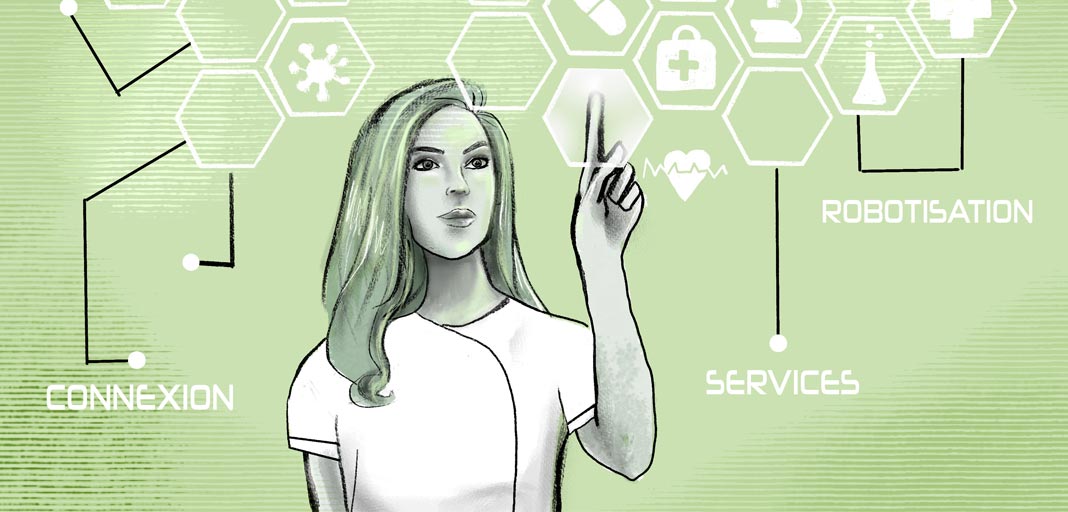What will the pharmacist of the future look like? 3D printing of patient-specific drugs, drone delivery, connected devices fed with data and artificial intelligence… In recent years, startups have been competing with each other to propose new ways of thinking about the patient experience and the care pathway. Is pharmacists role only to dispense medication? And if not, what will their role be tomorrow? Will technology jeopardize the profession or, on the contrary, make it even more exciting?
From temples in Ancient Egypt where physician-priests prepared remedies to dispensaries of the 20th century, the role of the pharmacist has definitely evolved. Yet the core of the profession has not changed: providing the right treatment, according to the prescriber’s intentions, while informing and advising patients on the proper use of the medicine.
I met Anca Petre who is a pharmacist, an expert in digital health and blockchain technology and cofounder of Medshake Studio, a series of podcasts on health topics.
1. After your career in pharmacy, you decided to focus on innovation and digital health. Can you explain your choice?

CEO at 23 Consulting
Cofounder at MedShake Podcast
“Combining innovation and health was the obvious way to continue to meet patient expectations.”
A.P.: I discovered entrepreneurship and new technologies during a hackathon when I was in my second year of pharmacy.
I was fascinated by how quickly we were able to provide a concrete technological response to a patient’s need.
During this event, we had worked on a diabetes monitoring application and within 48 hours we had already validated the need, defined the business model and produced a mock-up. In fact, this speed and agility contrasted sharply with the long drug development cycles I was studying at university. I think that’s when the trigger came.
New technologies are a great opportunity to offer relevant, effective and rapid solutions to patient needs that are not fully covered by the therapeutic approaches available today. Combining innovation and health was the obvious way to continue to meet patient expectations, either as a substitute or a complement to the traditional solutions I was studying. Traditional pharmacy is no longer sufficient.
2. What does it mean to you to be a good pharmacist? Is it a vocation or a job like any other?
A.P.: Pharmacists have the incredible advantage of mastering (almost) all the components of a health care system.
During our studies we acquire a lot of medical and pharmacological knowledge, but we also learn about health economics, production and development of health products.
“(…) a good pharmacist is above all someone who does not lose sight of the reason why we practice this profession: to help patients.”
This is the strength of this profession and what has allowed me to understand all aspects of health innovation. But beyond the advantage of our multidisciplinary studies, there is a higher purpose. A good pharmacist is above all someone who does not lose sight of the reason why we practice this profession: to help patients. As health care professionals, we have a duty to serve patients, whether we work in hospitals, offices or industry.
3. What is the nature of the relationship between dispensing pharmacists and their patients? What is their role in the patient journey?
A.P.: Pharmacists have a pivotal role in patient care. Regularly, they are the first point of contact when a patient has a health problem, even before consulting a doctor. For this reason, pharmacists are key players in the patient’s journey. Pharmacists being a local contact, patients often know them well and confide more easily about their state of health.
4. What relationship do pharmacists have with technology?
A.P.: The relationship between pharmacy and technology differs greatly from one professional to another.
Technology is not something that is part of being a pharmacist – unless you have a personal attraction to the subject. Some pharmacists are not likely to use digital tools. On the other hand, some of them really want to guide patients on technological solutions.
Many training courses are being developed to acculturate healthcare professionals to the contribution of new technologies. Although very few pharmacists attend these courses, I am optimistic. Patients’ expectations are evolving in terms of remote care and pharmacists will necessarily have to adapt.
5. The pharmacist of the future, how do you imagine him or her?
A.P.: The role of the pharmacist is likely to change dramatically in the years to come. In short, the human relationship and the therapeutic education provided to the patient will become much more important.
“(…) showing empathy is not something that, for the moment, can be done by a machine.”
A machine can reproduce the act of selling a drug quite easily. On the other hand, showing empathy is not something that, for the moment, can be done by a machine. Indeed, chatbots will not replace the wise and personalized advice of pharmacists who know their patients.
In the end, some people may argue that technology means much less contact with the patient. For example, thanks to voice assistants, patients will be able to order a drug from their couch and receive personalized advice from the AI on the basis of the recovered data. Thus, delivery will be possible by drone and renewal will be ensured automatically. It will then no longer be necessary to see your pharmacist. This scenario is deliberately extreme and provocative, but it is only by anticipating this type of scenario that one can evolve and change.
To go further…
“The pharmacy of the future? Personalized pills, 3D printed at home” – Daniel Kraft (TED Talks)
In a nutshell, Daniel Kraft (physician-scientist inventor and entrepreneur) argues that:
- Connected devices can track real-time vitals and generate data that can be seen by the patient and the medical team. Thus, health care professionals could use this data to optimize prevention or modify dosing and medication.
- In addition, “polypills” could be personalized to the patient’s condition (a “polypill” is the integration of multiple medication into a single pill).
- Furthermore, 3D printers are a fantastic tool to produce custom-made polypills. Patients would print their own medication every day, at the pharmacy or at home, according to their condition.
Credits: Illustration by © Jean Malgré Moi








